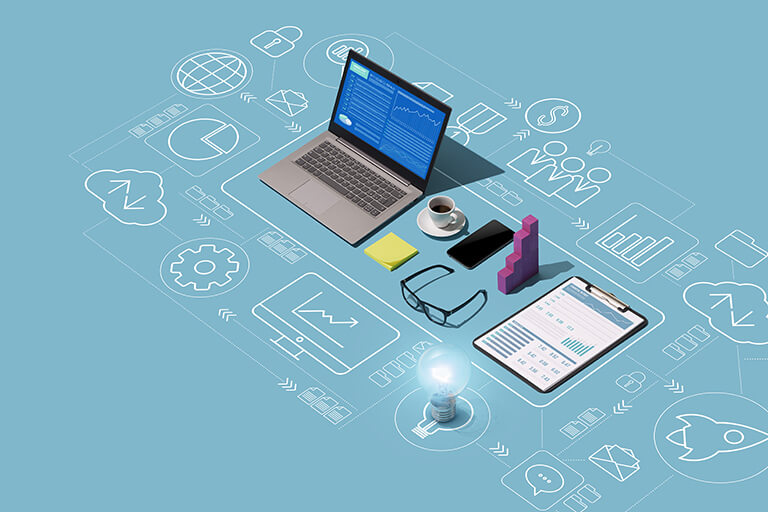7 New Tech Trends For Asia Pacific Businesses: Part 2
COVID-19 has rapidly accelerated digitization across APAC. And fast adoption of emergent tech is helping small businesses recover.
Digital transformation is changing the way we live, connect and increasingly, do business. Increasingly, Asia Pacific is at the forefront of digital innovation, and it’s the region’s SMEs who are often quickest to adopt new tech.
As with all trends, some are bigger than others. And some will have a greater impact on small businesses and their ability to achieve growth and tap new markets. We continue our essential rundown of the 7 essential tech trends in APAC below:
1. More connected, intelligent networks
The once sharply defined lines between digital and physical worlds are continuing to fade. Soon, we’ll see an environment where physical and digital worlds are closely and seamlessly interconnected.
This is about technology we don’t see – or even think about. Take for instance, banking. Already we tap to pay. Or healthcare – where sensors are bringing real-time insights to the secure movement of sensitive goods. The challenge for businesses? To ensure connectivity and intelligence that’s customer-centric.
Our own teams throughout Asia Pacific are increasingly using technology to personalize small business interactions and optimize delivery – simultaneously raising and serving customer expectations that would otherwise not be possible.
As with all trends, some are bigger than others. And some will have a greater impact on small businesses and their ability to achieve growth and tap new markets. We continue our essential rundown of the 7 essential tech trends in APAC below:
1. More connected, intelligent networks
The once sharply defined lines between digital and physical worlds are continuing to fade. Soon, we’ll see an environment where physical and digital worlds are closely and seamlessly interconnected.
This is about technology we don’t see – or even think about. Take for instance, banking. Already we tap to pay. Or healthcare – where sensors are bringing real-time insights to the secure movement of sensitive goods. The challenge for businesses? To ensure connectivity and intelligence that’s customer-centric.
Our own teams throughout Asia Pacific are increasingly using technology to personalize small business interactions and optimize delivery – simultaneously raising and serving customer expectations that would otherwise not be possible.

2. Optimizing customer experience with speed and agility
The convergence of technology and experience can re-imagine and transform what we do for customers. For instance, AirBnB has patented a system to help it better screen potential guests and hosts to improve experience and safety. And e-tailers are re-inventing the physical store experience, giving individual customers real-time advice on products to purchase.
It’s also about the emergence of other critical trends. For instance, Gartner predicts AI will be a mainstream customer experience investment in the next several years, with 15% of global customer service interactions to be handled completely by AI by 2021, up 400% from 2017.
3. Smart tech will accelerate cross-border B2B commerce
The ability to leverage smart technology is also going to accelerate one of the biggest trends we see right now – the massive growth of B2B cross-border commerce .
The global B2B e-commerce market was valued at US$14.9 trillion in 2020, more than 5 times the B2C market. Asia Pacific is way out in front with almost 80% of the B2B market. And APAC will continue to power one of the biggest trends in B2B – the rise of vertical marketplaces – with greater value-added services, including personalized customer experience.
The convergence of technology and experience can re-imagine and transform what we do for customers. For instance, AirBnB has patented a system to help it better screen potential guests and hosts to improve experience and safety. And e-tailers are re-inventing the physical store experience, giving individual customers real-time advice on products to purchase.
It’s also about the emergence of other critical trends. For instance, Gartner predicts AI will be a mainstream customer experience investment in the next several years, with 15% of global customer service interactions to be handled completely by AI by 2021, up 400% from 2017.
3. Smart tech will accelerate cross-border B2B commerce
The ability to leverage smart technology is also going to accelerate one of the biggest trends we see right now – the massive growth of B2B cross-border commerce .
The global B2B e-commerce market was valued at US$14.9 trillion in 2020, more than 5 times the B2C market. Asia Pacific is way out in front with almost 80% of the B2B market. And APAC will continue to power one of the biggest trends in B2B – the rise of vertical marketplaces – with greater value-added services, including personalized customer experience.

This new frontier of cross-border e-commerce, accelerated by COVID, is marked by an amazing array of technology. McKinsey says new technology in the logistics industry could cut shipping and customs processing times by as much as 28%. And by removing some of the friction that slows the movement of goods today, these technologies together could potentially boost overall trade from 6 % to 11% by 2030.
At FedEx, we’re working to enable B2B e-commerce through a number of smart solutions that make it easier and more seamless for businesses to move goods across borders and access export opportunities in new markets.
Innovation is essential for what’s next
The power of technology, and how it empowers businesses of all sizes to future-proof or enhance their operations, will continue to be crucial in the post-COVID era. From automation to AI, blockchain to the digitization of logistics, SMEs who embrace technology – even slowly and gradually – will be well-equipped for the decade ahead.
For more essential tips and Asia Pacific small business trends, head here.
At FedEx, we’re working to enable B2B e-commerce through a number of smart solutions that make it easier and more seamless for businesses to move goods across borders and access export opportunities in new markets.
Innovation is essential for what’s next
The power of technology, and how it empowers businesses of all sizes to future-proof or enhance their operations, will continue to be crucial in the post-COVID era. From automation to AI, blockchain to the digitization of logistics, SMEs who embrace technology – even slowly and gradually – will be well-equipped for the decade ahead.
For more essential tips and Asia Pacific small business trends, head here.
***





















 The Latest
The Latest